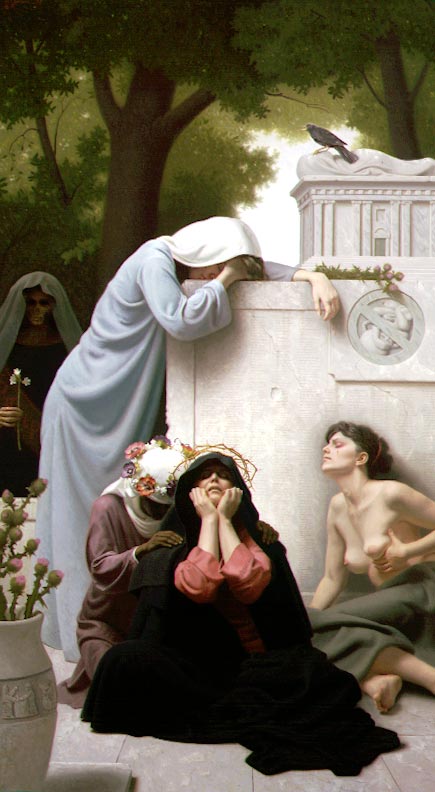|
|

|
Image
© Stephen Gjertson
Scan © Gandy Gallery |
| This dramatic image is an eloquent expression of the grief that many women say they have experienced after an abortion. The artist chose Rachel because she symbolizes the torment suffered by women who have lost their children. The mourners have gathered in a secluded glen at a defaced old monument for the preborn dead. Like the Vietnam Memorial, it is covered with names, only here they are anonymous: Baby Boy... Baby Girl... Baby Boy... Baby Girl.... The children remain unknown to all but those who mourn. Gold stars mark the names of babies whose lives were taken in the third trimester. The trees in the background symbolize the dignity of life. To express their anguish, some of the women have brought thistles with them. One woman clutches her breast, in grief at never having nourished her child. The comforter behind Rachel wears a wreath of interwoven anemones and baby's breath. Anemones are an ancient symbol of sorrow and death. A black bird, symbolic of sin, screeches from its perch on the desecrated body of a draped baby atop a clinic-turned-mausoleum. In the lower left is a vase carved with Babylonian figures sacrificing their firstborn to idols. Some of the folds in Rachel's black drapery are twisted into a grotesque monster showing that sin, though temporarily covered, will ultimately reveal itself. (Unfortunately, the drapery monster is invisible in the web reproduction.) From the background emerges a hooded figure, through whom a skeleton can be faintly seen, expressing the fact that evil deceives by masquerading as good. His ringed fingers hold out a narcissus, mythical symbol of self-love. In the past, the mourners had given in to the temptation of self-love and consented to the elimination of their preborn children. Aware of their folly, they no longer listen to his lies. The figure therefore turns his gaze upon us. |